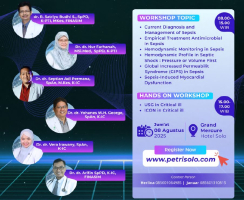WS2 Fullday : Current Diagnosis and Support Therapy of Sepsis
Event Information
| Event Date | 08-08-2025 8:00 am |
| Capacity | 60 |
| Location | Ruang B |
Agendas
| 8:00-9:00am |
Current diagnose and management of sepsisRecently updated definitions of sepsis and septic shock have been proposed which better identify patients who are likely to have a poor outcome, and therefore give an opportunity to escalate … |
| 09:00-10:00am |
Empirical Treatment in SepsisAntibiotics are fundamental in sepsis management; however, the optimal empirical treatment remains debated. Despite anaerobes rarely being the causative pathogen of sepsis, antibiotics targeting them are frequently used, which might lead to unintended consequences. |
| 10:00-11:00am |
Hemodynamic Monitoring in SepsisOptimal hemodynamic support in sepsis involves early fluid resuscitation with balanced crystalloids, timely initiation of norepinephrine, and dynamic assessment of fluid responsiveness to prevent fluid overload. |
| 13:00-14:00am |
Hemodynamic profile in Septic Shock : Pressure or Volume FirstIn severe sepsis and septic shock, systemic vascular resistance (SVR) and arterial elastance (Ea) are markedly decreased due to the vasodilatory effects of inflammatory mediators. This decrease in SVR leads to a lower end-systolic pressure (Pes), reflecting the reduced afterload on the heart. |
| 14:00-15:00am |
Global Increased Permeability Syndrome (GIPS) in SepsisGlobal Increased Permeability Syndrome (GIPS) "is characterised by high capillary leak index (CLI, expressed as the ratio of CRP over albumin x 100), excess interstitial fluid and … |
| 15:00-16:00am |
Sepsis Induced Myocardial DysfunctionSepsis-induced myocardial dysfunction (SIMD), also known as sepsis-induced cardiomyopathy (SICM), is linked to significantly increased mortality. Despite its clinical importance, effective therapies for SIMD remain elusive, largely due to an incomplete understanding of its pathogenesis. |
| 16:00-16:30am |
Hands On : USG in Critical illnessPoint-of-care ultrasonography (POCUS) is widely used by intensivists managing critically ill patients whereby they can accurately and rapidly assess for many pathologies such as pneumothorax, pulmonary edema, hydronephrosis, hemoperitoneum, and deep vein thrombosis among others. |
| 16:30-17:00am |
Hands On : ICON in Critical illnessPoint-of-care ultrasonography (POCUS) is widely used by intensivists managing critically ill patients whereby they can accurately and rapidly assess for many pathologies such as pneumothorax, pulmonary edema, hydronephrosis, hemoperitoneum, and deep vein thrombosis among others. |
Speakers

Dr. dr. Arifin, SpPD, KIC, FINASIM
Spesialis Penyakit Dalam dan Konsultan Terapi Intensif

dr. R. Satriyo B.S., SpPD, K-PTI, MKes, FINASIM
Spesialis Penyakit Dalam Konsultan Tropik Infeksi

Dr. dr. Yohanes W.H. George, Sp.An-TI, Subsp.T.I.(K)
Spesialis Anestesiologi dan Terapi Intensif Subspesialis Terapi Intensif

